Prevalence of Cardiovascular Diseases in Elderly People in Australia
VerifiedAdded on 2023/04/04
|15
|3653
|295
AI Summary
This essay analyzes the prevalence of cardiovascular diseases (CVDs) in elderly people in Australia and explores the impact of social determinants of health (SDOH) on the health issue. It also discusses key stakeholders who can address the health process and provides recommendations to reduce the burden of CVD in males.
Contribute Materials
Your contribution can guide someone’s learning journey. Share your
documents today.
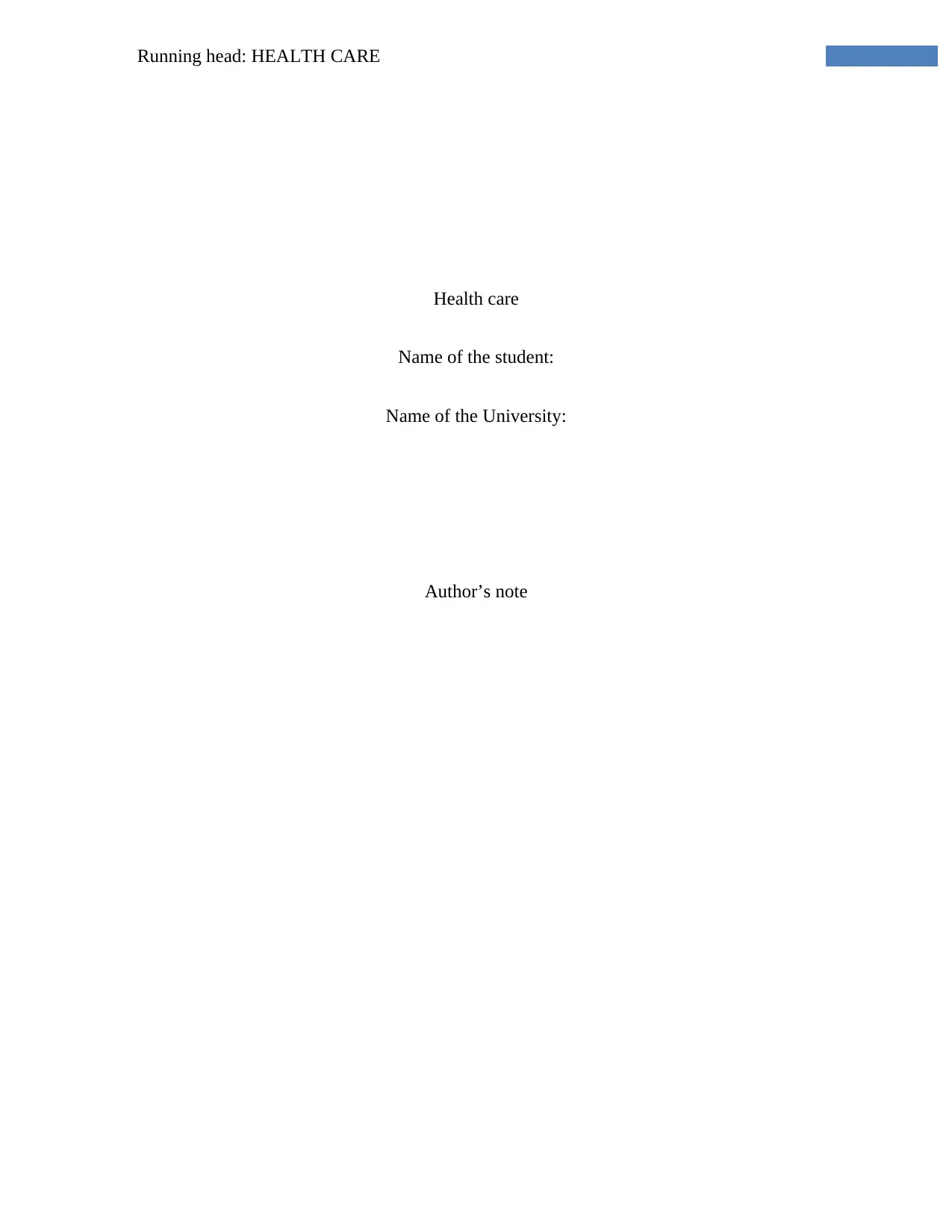
Running head: HEALTH CARE
Health care
Name of the student:
Name of the University:
Author’s note
Health care
Name of the student:
Name of the University:
Author’s note
Secure Best Marks with AI Grader
Need help grading? Try our AI Grader for instant feedback on your assignments.
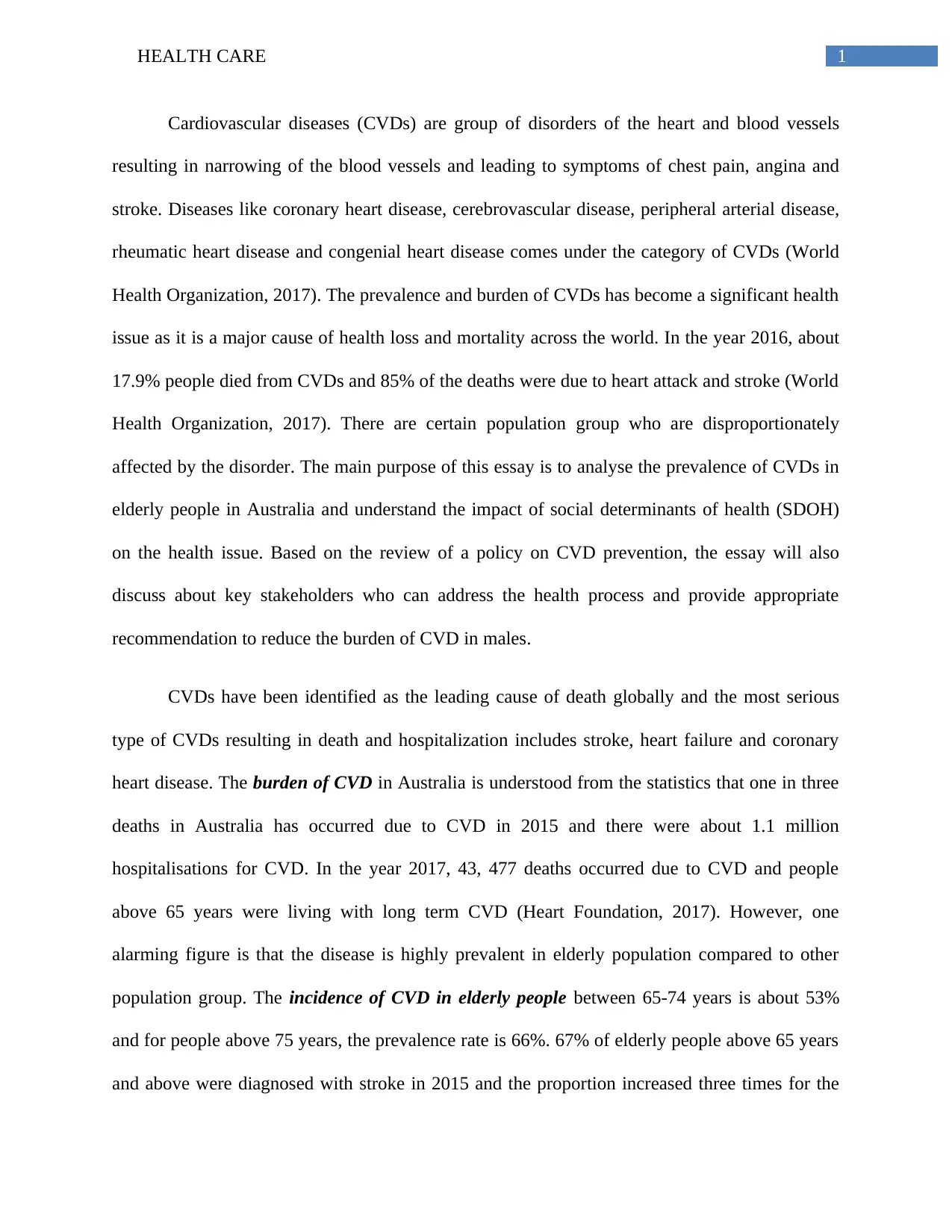
1HEALTH CARE
Cardiovascular diseases (CVDs) are group of disorders of the heart and blood vessels
resulting in narrowing of the blood vessels and leading to symptoms of chest pain, angina and
stroke. Diseases like coronary heart disease, cerebrovascular disease, peripheral arterial disease,
rheumatic heart disease and congenial heart disease comes under the category of CVDs (World
Health Organization, 2017). The prevalence and burden of CVDs has become a significant health
issue as it is a major cause of health loss and mortality across the world. In the year 2016, about
17.9% people died from CVDs and 85% of the deaths were due to heart attack and stroke (World
Health Organization, 2017). There are certain population group who are disproportionately
affected by the disorder. The main purpose of this essay is to analyse the prevalence of CVDs in
elderly people in Australia and understand the impact of social determinants of health (SDOH)
on the health issue. Based on the review of a policy on CVD prevention, the essay will also
discuss about key stakeholders who can address the health process and provide appropriate
recommendation to reduce the burden of CVD in males.
CVDs have been identified as the leading cause of death globally and the most serious
type of CVDs resulting in death and hospitalization includes stroke, heart failure and coronary
heart disease. The burden of CVD in Australia is understood from the statistics that one in three
deaths in Australia has occurred due to CVD in 2015 and there were about 1.1 million
hospitalisations for CVD. In the year 2017, 43, 477 deaths occurred due to CVD and people
above 65 years were living with long term CVD (Heart Foundation, 2017). However, one
alarming figure is that the disease is highly prevalent in elderly population compared to other
population group. The incidence of CVD in elderly people between 65-74 years is about 53%
and for people above 75 years, the prevalence rate is 66%. 67% of elderly people above 65 years
and above were diagnosed with stroke in 2015 and the proportion increased three times for the
Cardiovascular diseases (CVDs) are group of disorders of the heart and blood vessels
resulting in narrowing of the blood vessels and leading to symptoms of chest pain, angina and
stroke. Diseases like coronary heart disease, cerebrovascular disease, peripheral arterial disease,
rheumatic heart disease and congenial heart disease comes under the category of CVDs (World
Health Organization, 2017). The prevalence and burden of CVDs has become a significant health
issue as it is a major cause of health loss and mortality across the world. In the year 2016, about
17.9% people died from CVDs and 85% of the deaths were due to heart attack and stroke (World
Health Organization, 2017). There are certain population group who are disproportionately
affected by the disorder. The main purpose of this essay is to analyse the prevalence of CVDs in
elderly people in Australia and understand the impact of social determinants of health (SDOH)
on the health issue. Based on the review of a policy on CVD prevention, the essay will also
discuss about key stakeholders who can address the health process and provide appropriate
recommendation to reduce the burden of CVD in males.
CVDs have been identified as the leading cause of death globally and the most serious
type of CVDs resulting in death and hospitalization includes stroke, heart failure and coronary
heart disease. The burden of CVD in Australia is understood from the statistics that one in three
deaths in Australia has occurred due to CVD in 2015 and there were about 1.1 million
hospitalisations for CVD. In the year 2017, 43, 477 deaths occurred due to CVD and people
above 65 years were living with long term CVD (Heart Foundation, 2017). However, one
alarming figure is that the disease is highly prevalent in elderly population compared to other
population group. The incidence of CVD in elderly people between 65-74 years is about 53%
and for people above 75 years, the prevalence rate is 66%. 67% of elderly people above 65 years
and above were diagnosed with stroke in 2015 and the proportion increased three times for the

2HEALTH CARE
elderly population group (Australian Institute of Health and Welfare, 2018). In addition, the rate
of hospitalization and death is found to be the highest for lower socioeconomic groups and those
living in remote areas (Heart Foundation, 2017). Hence, the ultimate impact of CVD on elderly
is understood from the above statistics.
Ageing is one of the factors linked to high risk of CVD. This is said because aging leads
to progressive decline in various physiological processes and this has an impact on heart and
arterial systems too. The cardiovascular tissues of elderly people are subjected to certain
alterations like increased arterial stiffness, diminished systolic reverse capacity and hypertrophy.
This increased the likelihood of developing conditions like hypertension, stroke, artherosclerosis
and myocardial infarction (North & Sinclair, 2012). With the increase in ageing population, the
rate of increase in CVD risk for elderly people should be taken with precaution. Some of the
established risk factors for CVD include smoking, obesity, hypertension and family history of
CVDs. High blood pressure is the common risk factor and it is a common condition for almost
all older adults (Wu et al., 2015). Miller et al. (2016) gives the evidence that hypertension and
CVD incidence and prevalence increase dramatically with age because of exposure to age
associated increase in arterial stiffness. This implies that treatment of hypertension can reduce
risk of stroke and coronary heart disease and promotion functional ability and independence
among elderly people. The impact of hypertension on CVD risk and on mortality rate among
older adults needs is a significant health issue that needs the attention of health care
professionals.
The risk of CVD in elderly people is also influenced by SDOH. Social determinants of
health are the conditions where people live, work and grow. Hence, poor access to SDOH may
also increase the risk of CVD. WHO definition for SDOH states health and illness are not
elderly population group (Australian Institute of Health and Welfare, 2018). In addition, the rate
of hospitalization and death is found to be the highest for lower socioeconomic groups and those
living in remote areas (Heart Foundation, 2017). Hence, the ultimate impact of CVD on elderly
is understood from the above statistics.
Ageing is one of the factors linked to high risk of CVD. This is said because aging leads
to progressive decline in various physiological processes and this has an impact on heart and
arterial systems too. The cardiovascular tissues of elderly people are subjected to certain
alterations like increased arterial stiffness, diminished systolic reverse capacity and hypertrophy.
This increased the likelihood of developing conditions like hypertension, stroke, artherosclerosis
and myocardial infarction (North & Sinclair, 2012). With the increase in ageing population, the
rate of increase in CVD risk for elderly people should be taken with precaution. Some of the
established risk factors for CVD include smoking, obesity, hypertension and family history of
CVDs. High blood pressure is the common risk factor and it is a common condition for almost
all older adults (Wu et al., 2015). Miller et al. (2016) gives the evidence that hypertension and
CVD incidence and prevalence increase dramatically with age because of exposure to age
associated increase in arterial stiffness. This implies that treatment of hypertension can reduce
risk of stroke and coronary heart disease and promotion functional ability and independence
among elderly people. The impact of hypertension on CVD risk and on mortality rate among
older adults needs is a significant health issue that needs the attention of health care
professionals.
The risk of CVD in elderly people is also influenced by SDOH. Social determinants of
health are the conditions where people live, work and grow. Hence, poor access to SDOH may
also increase the risk of CVD. WHO definition for SDOH states health and illness are not
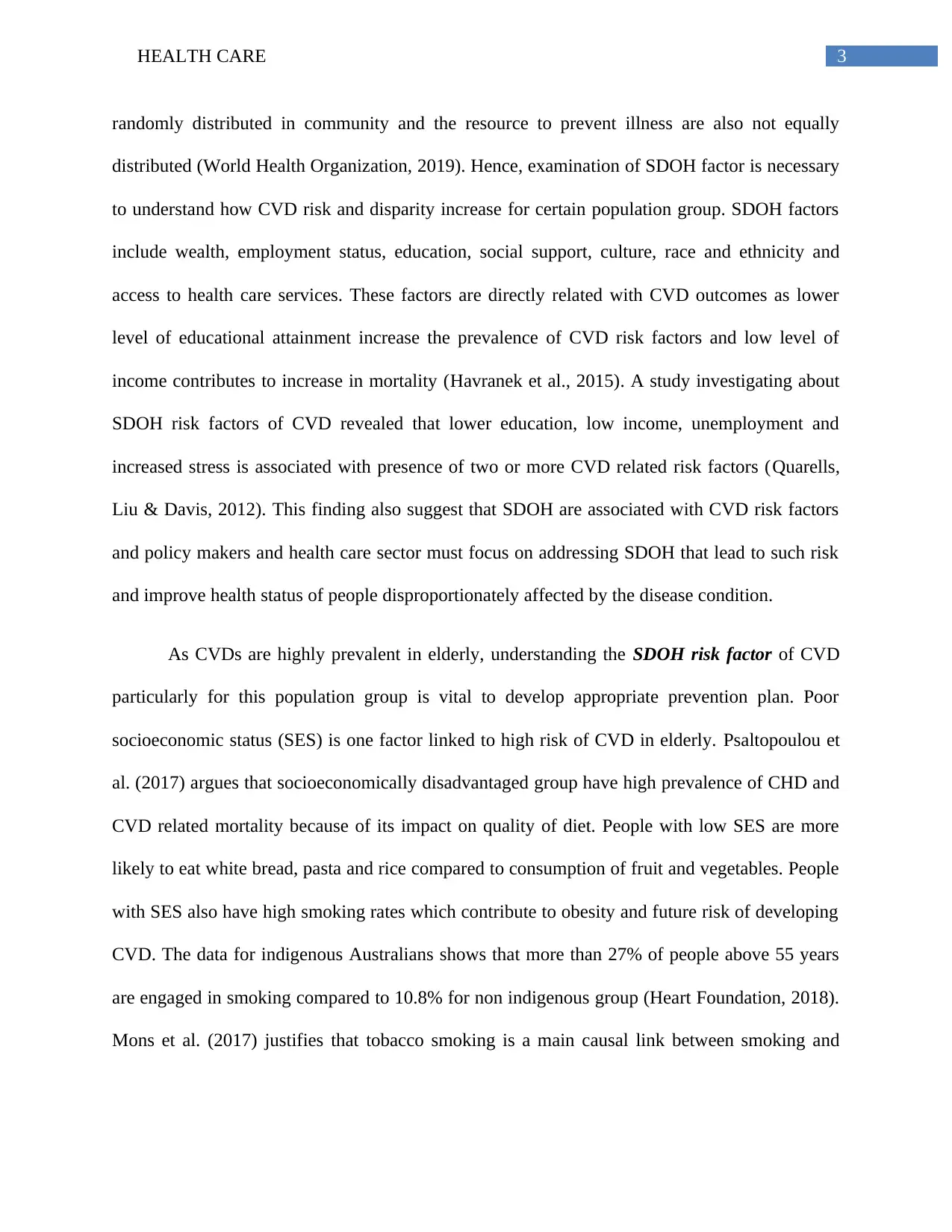
3HEALTH CARE
randomly distributed in community and the resource to prevent illness are also not equally
distributed (World Health Organization, 2019). Hence, examination of SDOH factor is necessary
to understand how CVD risk and disparity increase for certain population group. SDOH factors
include wealth, employment status, education, social support, culture, race and ethnicity and
access to health care services. These factors are directly related with CVD outcomes as lower
level of educational attainment increase the prevalence of CVD risk factors and low level of
income contributes to increase in mortality (Havranek et al., 2015). A study investigating about
SDOH risk factors of CVD revealed that lower education, low income, unemployment and
increased stress is associated with presence of two or more CVD related risk factors (Quarells,
Liu & Davis, 2012). This finding also suggest that SDOH are associated with CVD risk factors
and policy makers and health care sector must focus on addressing SDOH that lead to such risk
and improve health status of people disproportionately affected by the disease condition.
As CVDs are highly prevalent in elderly, understanding the SDOH risk factor of CVD
particularly for this population group is vital to develop appropriate prevention plan. Poor
socioeconomic status (SES) is one factor linked to high risk of CVD in elderly. Psaltopoulou et
al. (2017) argues that socioeconomically disadvantaged group have high prevalence of CHD and
CVD related mortality because of its impact on quality of diet. People with low SES are more
likely to eat white bread, pasta and rice compared to consumption of fruit and vegetables. People
with SES also have high smoking rates which contribute to obesity and future risk of developing
CVD. The data for indigenous Australians shows that more than 27% of people above 55 years
are engaged in smoking compared to 10.8% for non indigenous group (Heart Foundation, 2018).
Mons et al. (2017) justifies that tobacco smoking is a main causal link between smoking and
randomly distributed in community and the resource to prevent illness are also not equally
distributed (World Health Organization, 2019). Hence, examination of SDOH factor is necessary
to understand how CVD risk and disparity increase for certain population group. SDOH factors
include wealth, employment status, education, social support, culture, race and ethnicity and
access to health care services. These factors are directly related with CVD outcomes as lower
level of educational attainment increase the prevalence of CVD risk factors and low level of
income contributes to increase in mortality (Havranek et al., 2015). A study investigating about
SDOH risk factors of CVD revealed that lower education, low income, unemployment and
increased stress is associated with presence of two or more CVD related risk factors (Quarells,
Liu & Davis, 2012). This finding also suggest that SDOH are associated with CVD risk factors
and policy makers and health care sector must focus on addressing SDOH that lead to such risk
and improve health status of people disproportionately affected by the disease condition.
As CVDs are highly prevalent in elderly, understanding the SDOH risk factor of CVD
particularly for this population group is vital to develop appropriate prevention plan. Poor
socioeconomic status (SES) is one factor linked to high risk of CVD in elderly. Psaltopoulou et
al. (2017) argues that socioeconomically disadvantaged group have high prevalence of CHD and
CVD related mortality because of its impact on quality of diet. People with low SES are more
likely to eat white bread, pasta and rice compared to consumption of fruit and vegetables. People
with SES also have high smoking rates which contribute to obesity and future risk of developing
CVD. The data for indigenous Australians shows that more than 27% of people above 55 years
are engaged in smoking compared to 10.8% for non indigenous group (Heart Foundation, 2018).
Mons et al. (2017) justifies that tobacco smoking is a main causal link between smoking and
Secure Best Marks with AI Grader
Need help grading? Try our AI Grader for instant feedback on your assignments.
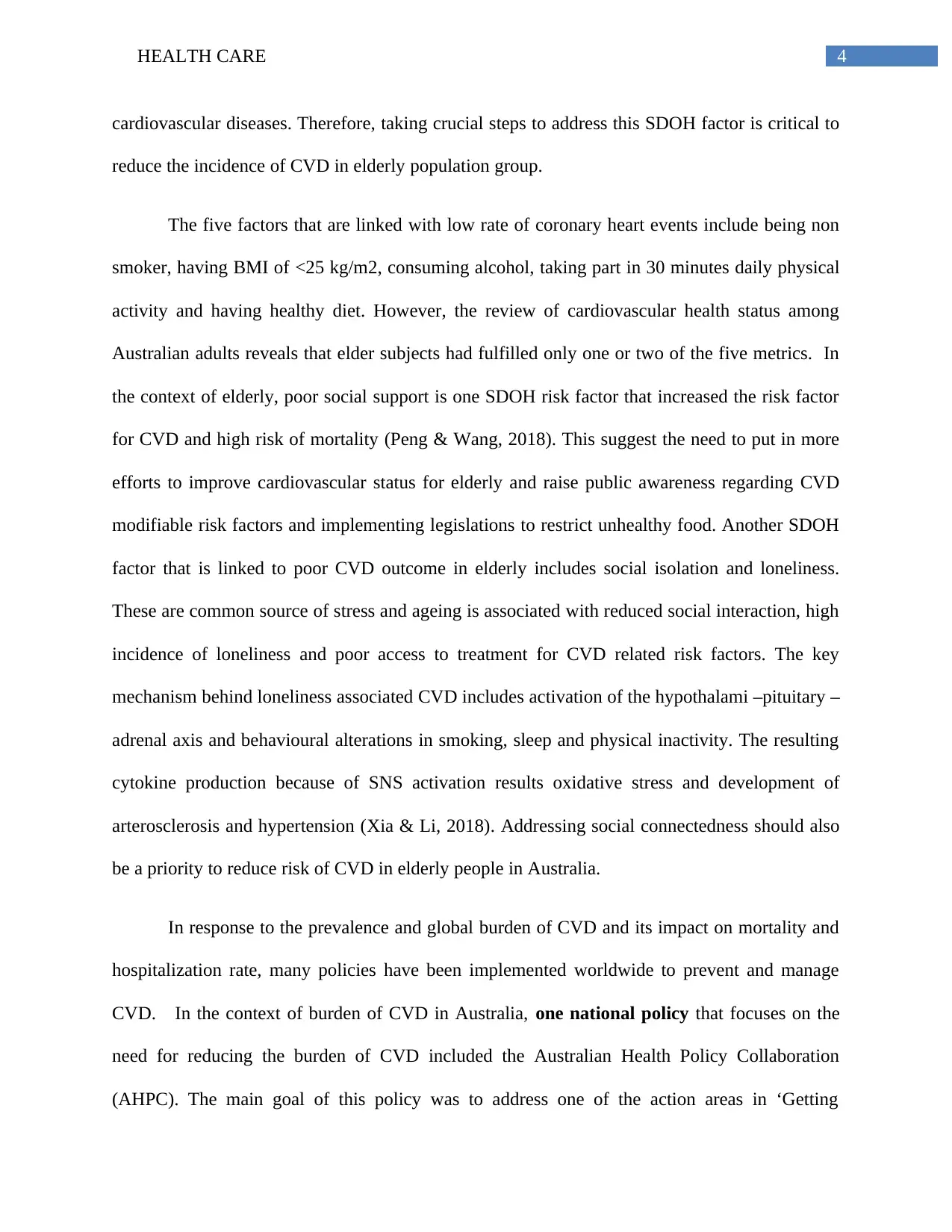
4HEALTH CARE
cardiovascular diseases. Therefore, taking crucial steps to address this SDOH factor is critical to
reduce the incidence of CVD in elderly population group.
The five factors that are linked with low rate of coronary heart events include being non
smoker, having BMI of <25 kg/m2, consuming alcohol, taking part in 30 minutes daily physical
activity and having healthy diet. However, the review of cardiovascular health status among
Australian adults reveals that elder subjects had fulfilled only one or two of the five metrics. In
the context of elderly, poor social support is one SDOH risk factor that increased the risk factor
for CVD and high risk of mortality (Peng & Wang, 2018). This suggest the need to put in more
efforts to improve cardiovascular status for elderly and raise public awareness regarding CVD
modifiable risk factors and implementing legislations to restrict unhealthy food. Another SDOH
factor that is linked to poor CVD outcome in elderly includes social isolation and loneliness.
These are common source of stress and ageing is associated with reduced social interaction, high
incidence of loneliness and poor access to treatment for CVD related risk factors. The key
mechanism behind loneliness associated CVD includes activation of the hypothalami –pituitary –
adrenal axis and behavioural alterations in smoking, sleep and physical inactivity. The resulting
cytokine production because of SNS activation results oxidative stress and development of
arterosclerosis and hypertension (Xia & Li, 2018). Addressing social connectedness should also
be a priority to reduce risk of CVD in elderly people in Australia.
In response to the prevalence and global burden of CVD and its impact on mortality and
hospitalization rate, many policies have been implemented worldwide to prevent and manage
CVD. In the context of burden of CVD in Australia, one national policy that focuses on the
need for reducing the burden of CVD included the Australian Health Policy Collaboration
(AHPC). The main goal of this policy was to address one of the action areas in ‘Getting
cardiovascular diseases. Therefore, taking crucial steps to address this SDOH factor is critical to
reduce the incidence of CVD in elderly population group.
The five factors that are linked with low rate of coronary heart events include being non
smoker, having BMI of <25 kg/m2, consuming alcohol, taking part in 30 minutes daily physical
activity and having healthy diet. However, the review of cardiovascular health status among
Australian adults reveals that elder subjects had fulfilled only one or two of the five metrics. In
the context of elderly, poor social support is one SDOH risk factor that increased the risk factor
for CVD and high risk of mortality (Peng & Wang, 2018). This suggest the need to put in more
efforts to improve cardiovascular status for elderly and raise public awareness regarding CVD
modifiable risk factors and implementing legislations to restrict unhealthy food. Another SDOH
factor that is linked to poor CVD outcome in elderly includes social isolation and loneliness.
These are common source of stress and ageing is associated with reduced social interaction, high
incidence of loneliness and poor access to treatment for CVD related risk factors. The key
mechanism behind loneliness associated CVD includes activation of the hypothalami –pituitary –
adrenal axis and behavioural alterations in smoking, sleep and physical inactivity. The resulting
cytokine production because of SNS activation results oxidative stress and development of
arterosclerosis and hypertension (Xia & Li, 2018). Addressing social connectedness should also
be a priority to reduce risk of CVD in elderly people in Australia.
In response to the prevalence and global burden of CVD and its impact on mortality and
hospitalization rate, many policies have been implemented worldwide to prevent and manage
CVD. In the context of burden of CVD in Australia, one national policy that focuses on the
need for reducing the burden of CVD included the Australian Health Policy Collaboration
(AHPC). The main goal of this policy was to address one of the action areas in ‘Getting
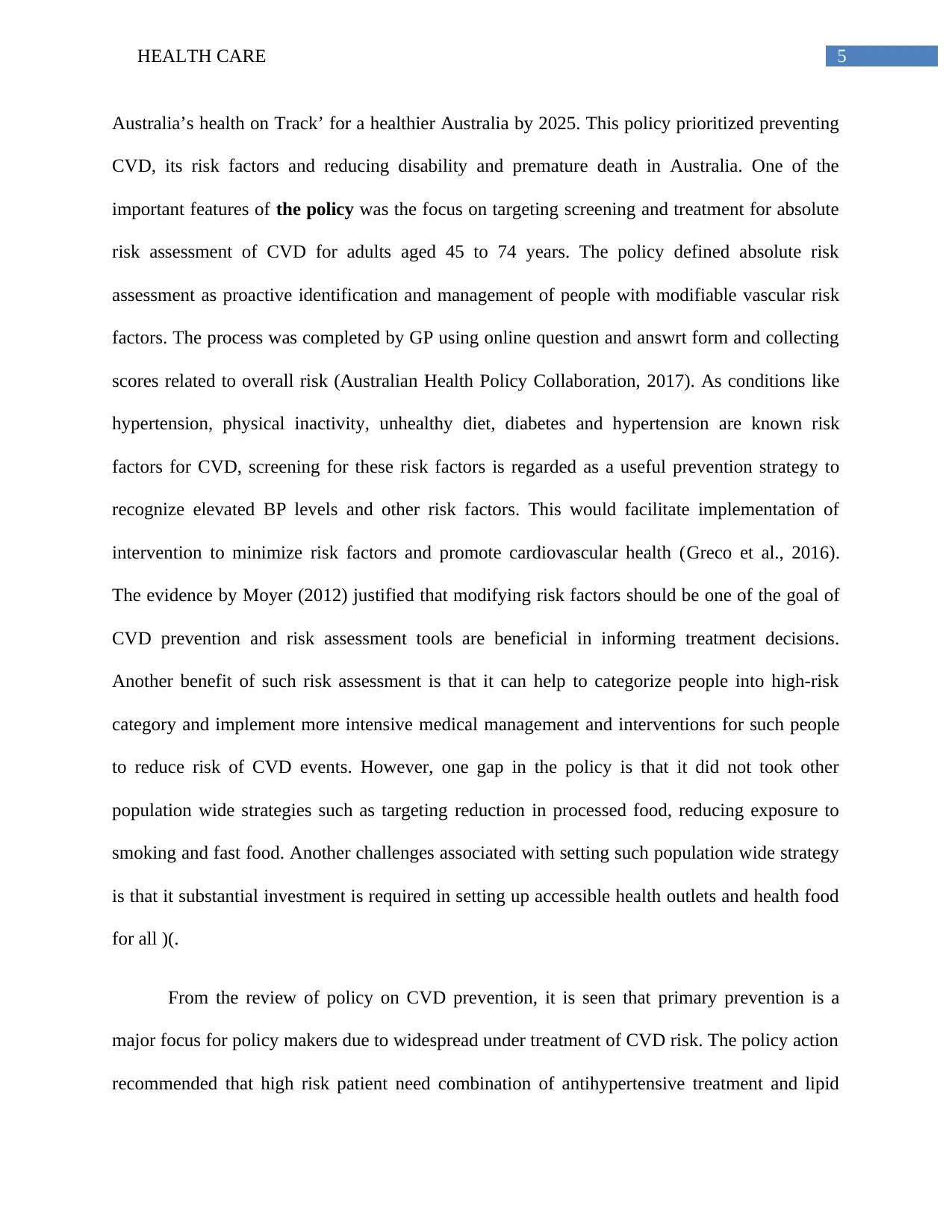
5HEALTH CARE
Australia’s health on Track’ for a healthier Australia by 2025. This policy prioritized preventing
CVD, its risk factors and reducing disability and premature death in Australia. One of the
important features of the policy was the focus on targeting screening and treatment for absolute
risk assessment of CVD for adults aged 45 to 74 years. The policy defined absolute risk
assessment as proactive identification and management of people with modifiable vascular risk
factors. The process was completed by GP using online question and answrt form and collecting
scores related to overall risk (Australian Health Policy Collaboration, 2017). As conditions like
hypertension, physical inactivity, unhealthy diet, diabetes and hypertension are known risk
factors for CVD, screening for these risk factors is regarded as a useful prevention strategy to
recognize elevated BP levels and other risk factors. This would facilitate implementation of
intervention to minimize risk factors and promote cardiovascular health (Greco et al., 2016).
The evidence by Moyer (2012) justified that modifying risk factors should be one of the goal of
CVD prevention and risk assessment tools are beneficial in informing treatment decisions.
Another benefit of such risk assessment is that it can help to categorize people into high-risk
category and implement more intensive medical management and interventions for such people
to reduce risk of CVD events. However, one gap in the policy is that it did not took other
population wide strategies such as targeting reduction in processed food, reducing exposure to
smoking and fast food. Another challenges associated with setting such population wide strategy
is that it substantial investment is required in setting up accessible health outlets and health food
for all )(.
From the review of policy on CVD prevention, it is seen that primary prevention is a
major focus for policy makers due to widespread under treatment of CVD risk. The policy action
recommended that high risk patient need combination of antihypertensive treatment and lipid
Australia’s health on Track’ for a healthier Australia by 2025. This policy prioritized preventing
CVD, its risk factors and reducing disability and premature death in Australia. One of the
important features of the policy was the focus on targeting screening and treatment for absolute
risk assessment of CVD for adults aged 45 to 74 years. The policy defined absolute risk
assessment as proactive identification and management of people with modifiable vascular risk
factors. The process was completed by GP using online question and answrt form and collecting
scores related to overall risk (Australian Health Policy Collaboration, 2017). As conditions like
hypertension, physical inactivity, unhealthy diet, diabetes and hypertension are known risk
factors for CVD, screening for these risk factors is regarded as a useful prevention strategy to
recognize elevated BP levels and other risk factors. This would facilitate implementation of
intervention to minimize risk factors and promote cardiovascular health (Greco et al., 2016).
The evidence by Moyer (2012) justified that modifying risk factors should be one of the goal of
CVD prevention and risk assessment tools are beneficial in informing treatment decisions.
Another benefit of such risk assessment is that it can help to categorize people into high-risk
category and implement more intensive medical management and interventions for such people
to reduce risk of CVD events. However, one gap in the policy is that it did not took other
population wide strategies such as targeting reduction in processed food, reducing exposure to
smoking and fast food. Another challenges associated with setting such population wide strategy
is that it substantial investment is required in setting up accessible health outlets and health food
for all )(.
From the review of policy on CVD prevention, it is seen that primary prevention is a
major focus for policy makers due to widespread under treatment of CVD risk. The policy action
recommended that high risk patient need combination of antihypertensive treatment and lipid

6HEALTH CARE
lowering therapy. However, only one-third of very high risk patients aged 45 to 74 years receive
this combination. Apart from Absolute Cardiovascular Risk Assessment, the policy actions on
Getting Australia’s health on Track’ also prioritized treatment and management for people who
already have CVD. Despite this, the major focus of the policy was on providing comprehensive
support for Absolute Cardiovascular Risk Assessment. Accurate measurement will favour
implementation of effective treatments such as medical intervention, lifestyle intervention and
behavioural changes (Australian Health Policy Collaboration, 2017).
Based on the review of the prevalence of CVD in elderly and the SDOH risk factors that
predispose elderly population to high prevalence of risk, it can be said that hypertension, poor
SES, social isolation, increases rate of smoking and poor lifestyle are the main cause behind
diagnosis of CVD. In addition, the main SDOH that contributes to health related disadvantage
for the group includes poor SES and poor social connectedness. Hence, to address the social
determinants factor that lead to CVD prevalence in elder, it is necessary to identify potential
stakeholders who can promote health for the group. These stakeholders include policy makers,
health promotion staffs, dieticians, social workers, nurses, community health workers,
epidemiologist and health care professionals. Policy maker’s role is critical in reducing health
inequalities in specific population group. Policy makers are the most important stakeholders as
they can work directly influence a system of change and create positive environment for change.
Currently government policies related to CVD has focussed on regulating taxed to reduce
cigarette smoking, passes legislation to control obesity, proposed strategies to help people make
healthier choices and improve lives of people (Angell et al., 2014). However, based on
discussion on impact of SDOH on health risk for the chosen population group, there is a need to
attract policy maker’s attention to these factors.
lowering therapy. However, only one-third of very high risk patients aged 45 to 74 years receive
this combination. Apart from Absolute Cardiovascular Risk Assessment, the policy actions on
Getting Australia’s health on Track’ also prioritized treatment and management for people who
already have CVD. Despite this, the major focus of the policy was on providing comprehensive
support for Absolute Cardiovascular Risk Assessment. Accurate measurement will favour
implementation of effective treatments such as medical intervention, lifestyle intervention and
behavioural changes (Australian Health Policy Collaboration, 2017).
Based on the review of the prevalence of CVD in elderly and the SDOH risk factors that
predispose elderly population to high prevalence of risk, it can be said that hypertension, poor
SES, social isolation, increases rate of smoking and poor lifestyle are the main cause behind
diagnosis of CVD. In addition, the main SDOH that contributes to health related disadvantage
for the group includes poor SES and poor social connectedness. Hence, to address the social
determinants factor that lead to CVD prevalence in elder, it is necessary to identify potential
stakeholders who can promote health for the group. These stakeholders include policy makers,
health promotion staffs, dieticians, social workers, nurses, community health workers,
epidemiologist and health care professionals. Policy maker’s role is critical in reducing health
inequalities in specific population group. Policy makers are the most important stakeholders as
they can work directly influence a system of change and create positive environment for change.
Currently government policies related to CVD has focussed on regulating taxed to reduce
cigarette smoking, passes legislation to control obesity, proposed strategies to help people make
healthier choices and improve lives of people (Angell et al., 2014). However, based on
discussion on impact of SDOH on health risk for the chosen population group, there is a need to
attract policy maker’s attention to these factors.
Paraphrase This Document
Need a fresh take? Get an instant paraphrase of this document with our AI Paraphraser
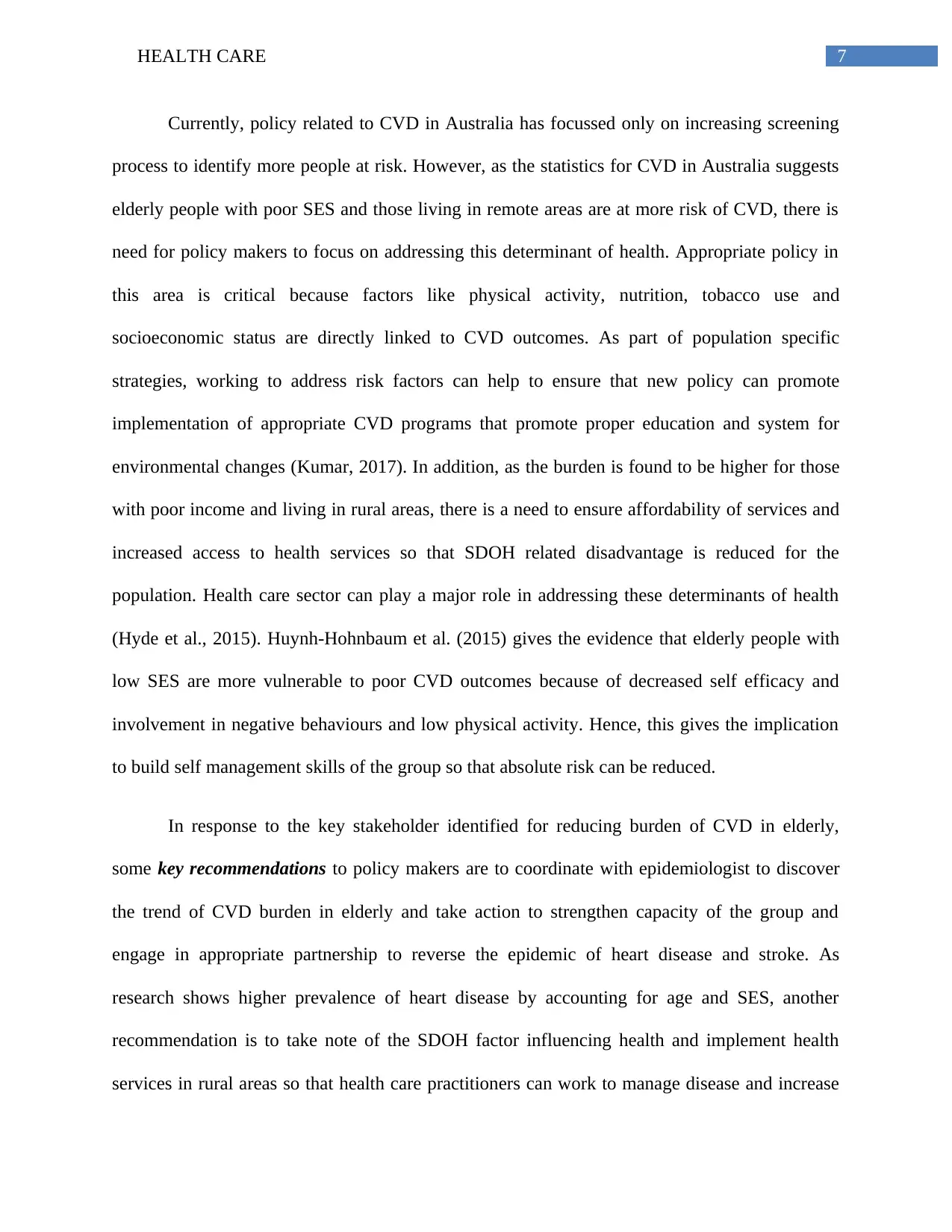
7HEALTH CARE
Currently, policy related to CVD in Australia has focussed only on increasing screening
process to identify more people at risk. However, as the statistics for CVD in Australia suggests
elderly people with poor SES and those living in remote areas are at more risk of CVD, there is
need for policy makers to focus on addressing this determinant of health. Appropriate policy in
this area is critical because factors like physical activity, nutrition, tobacco use and
socioeconomic status are directly linked to CVD outcomes. As part of population specific
strategies, working to address risk factors can help to ensure that new policy can promote
implementation of appropriate CVD programs that promote proper education and system for
environmental changes (Kumar, 2017). In addition, as the burden is found to be higher for those
with poor income and living in rural areas, there is a need to ensure affordability of services and
increased access to health services so that SDOH related disadvantage is reduced for the
population. Health care sector can play a major role in addressing these determinants of health
(Hyde et al., 2015). Huynh-Hohnbaum et al. (2015) gives the evidence that elderly people with
low SES are more vulnerable to poor CVD outcomes because of decreased self efficacy and
involvement in negative behaviours and low physical activity. Hence, this gives the implication
to build self management skills of the group so that absolute risk can be reduced.
In response to the key stakeholder identified for reducing burden of CVD in elderly,
some key recommendations to policy makers are to coordinate with epidemiologist to discover
the trend of CVD burden in elderly and take action to strengthen capacity of the group and
engage in appropriate partnership to reverse the epidemic of heart disease and stroke. As
research shows higher prevalence of heart disease by accounting for age and SES, another
recommendation is to take note of the SDOH factor influencing health and implement health
services in rural areas so that health care practitioners can work to manage disease and increase
Currently, policy related to CVD in Australia has focussed only on increasing screening
process to identify more people at risk. However, as the statistics for CVD in Australia suggests
elderly people with poor SES and those living in remote areas are at more risk of CVD, there is
need for policy makers to focus on addressing this determinant of health. Appropriate policy in
this area is critical because factors like physical activity, nutrition, tobacco use and
socioeconomic status are directly linked to CVD outcomes. As part of population specific
strategies, working to address risk factors can help to ensure that new policy can promote
implementation of appropriate CVD programs that promote proper education and system for
environmental changes (Kumar, 2017). In addition, as the burden is found to be higher for those
with poor income and living in rural areas, there is a need to ensure affordability of services and
increased access to health services so that SDOH related disadvantage is reduced for the
population. Health care sector can play a major role in addressing these determinants of health
(Hyde et al., 2015). Huynh-Hohnbaum et al. (2015) gives the evidence that elderly people with
low SES are more vulnerable to poor CVD outcomes because of decreased self efficacy and
involvement in negative behaviours and low physical activity. Hence, this gives the implication
to build self management skills of the group so that absolute risk can be reduced.
In response to the key stakeholder identified for reducing burden of CVD in elderly,
some key recommendations to policy makers are to coordinate with epidemiologist to discover
the trend of CVD burden in elderly and take action to strengthen capacity of the group and
engage in appropriate partnership to reverse the epidemic of heart disease and stroke. As
research shows higher prevalence of heart disease by accounting for age and SES, another
recommendation is to take note of the SDOH factor influencing health and implement health
services in rural areas so that health care practitioners can work to manage disease and increase
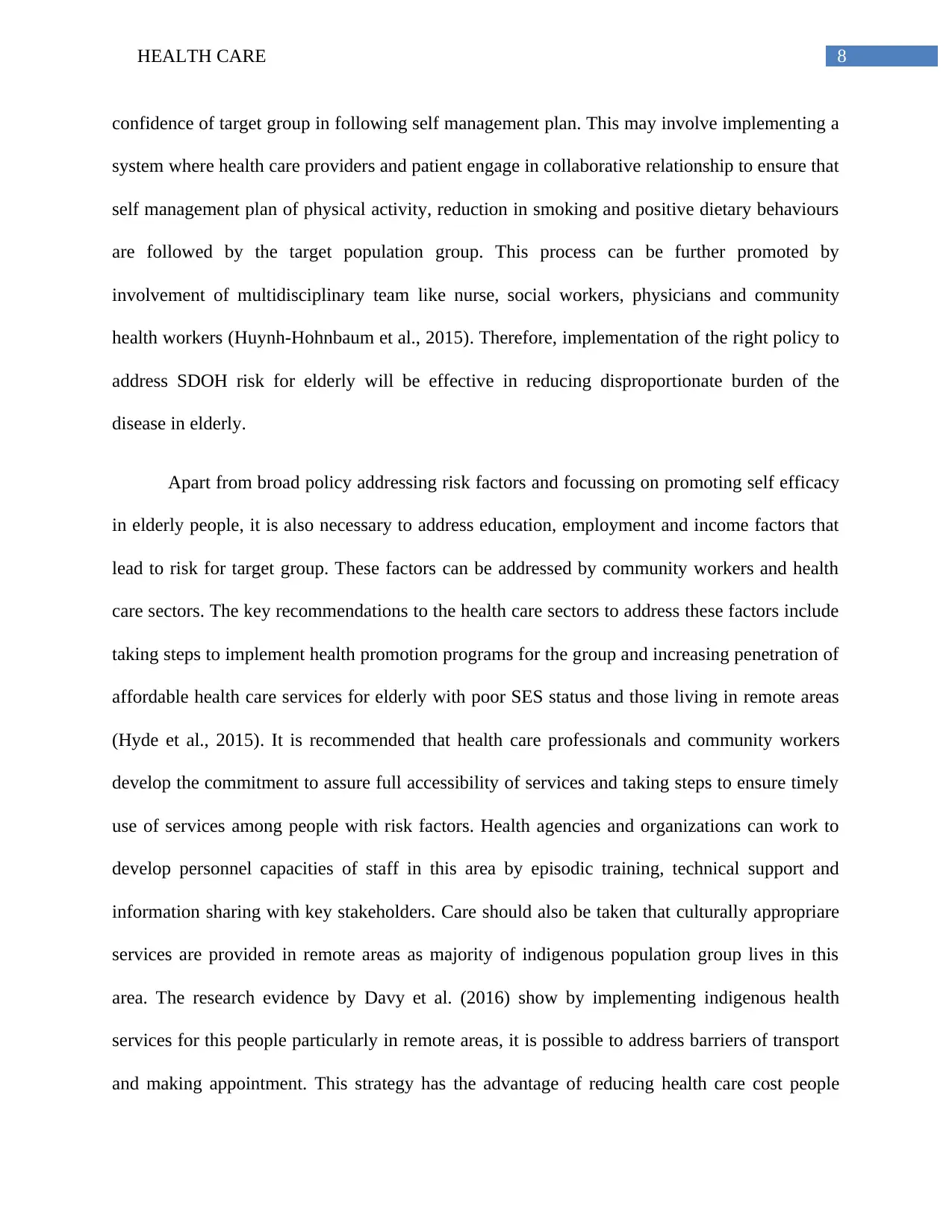
8HEALTH CARE
confidence of target group in following self management plan. This may involve implementing a
system where health care providers and patient engage in collaborative relationship to ensure that
self management plan of physical activity, reduction in smoking and positive dietary behaviours
are followed by the target population group. This process can be further promoted by
involvement of multidisciplinary team like nurse, social workers, physicians and community
health workers (Huynh-Hohnbaum et al., 2015). Therefore, implementation of the right policy to
address SDOH risk for elderly will be effective in reducing disproportionate burden of the
disease in elderly.
Apart from broad policy addressing risk factors and focussing on promoting self efficacy
in elderly people, it is also necessary to address education, employment and income factors that
lead to risk for target group. These factors can be addressed by community workers and health
care sectors. The key recommendations to the health care sectors to address these factors include
taking steps to implement health promotion programs for the group and increasing penetration of
affordable health care services for elderly with poor SES status and those living in remote areas
(Hyde et al., 2015). It is recommended that health care professionals and community workers
develop the commitment to assure full accessibility of services and taking steps to ensure timely
use of services among people with risk factors. Health agencies and organizations can work to
develop personnel capacities of staff in this area by episodic training, technical support and
information sharing with key stakeholders. Care should also be taken that culturally appropriare
services are provided in remote areas as majority of indigenous population group lives in this
area. The research evidence by Davy et al. (2016) show by implementing indigenous health
services for this people particularly in remote areas, it is possible to address barriers of transport
and making appointment. This strategy has the advantage of reducing health care cost people
confidence of target group in following self management plan. This may involve implementing a
system where health care providers and patient engage in collaborative relationship to ensure that
self management plan of physical activity, reduction in smoking and positive dietary behaviours
are followed by the target population group. This process can be further promoted by
involvement of multidisciplinary team like nurse, social workers, physicians and community
health workers (Huynh-Hohnbaum et al., 2015). Therefore, implementation of the right policy to
address SDOH risk for elderly will be effective in reducing disproportionate burden of the
disease in elderly.
Apart from broad policy addressing risk factors and focussing on promoting self efficacy
in elderly people, it is also necessary to address education, employment and income factors that
lead to risk for target group. These factors can be addressed by community workers and health
care sectors. The key recommendations to the health care sectors to address these factors include
taking steps to implement health promotion programs for the group and increasing penetration of
affordable health care services for elderly with poor SES status and those living in remote areas
(Hyde et al., 2015). It is recommended that health care professionals and community workers
develop the commitment to assure full accessibility of services and taking steps to ensure timely
use of services among people with risk factors. Health agencies and organizations can work to
develop personnel capacities of staff in this area by episodic training, technical support and
information sharing with key stakeholders. Care should also be taken that culturally appropriare
services are provided in remote areas as majority of indigenous population group lives in this
area. The research evidence by Davy et al. (2016) show by implementing indigenous health
services for this people particularly in remote areas, it is possible to address barriers of transport
and making appointment. This strategy has the advantage of reducing health care cost people
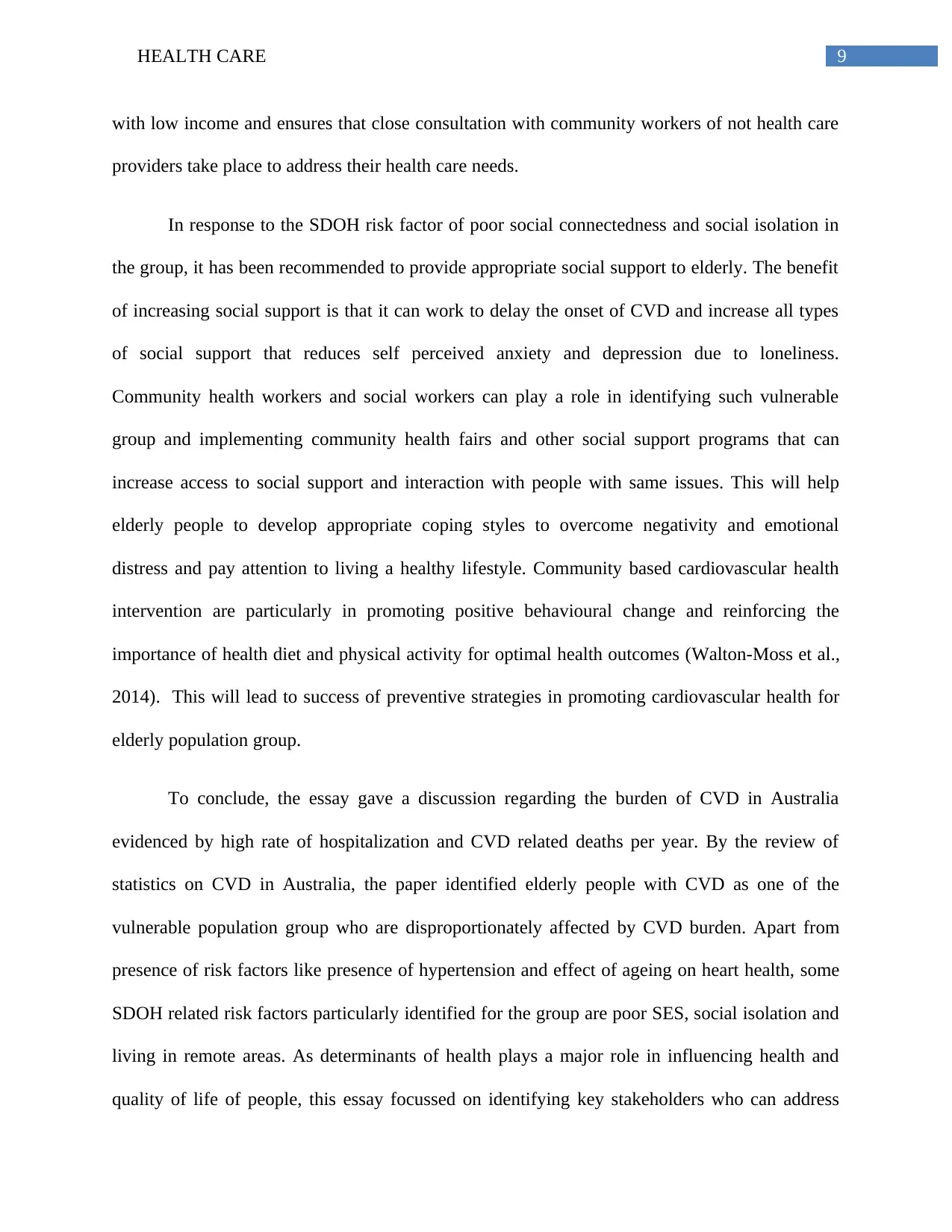
9HEALTH CARE
with low income and ensures that close consultation with community workers of not health care
providers take place to address their health care needs.
In response to the SDOH risk factor of poor social connectedness and social isolation in
the group, it has been recommended to provide appropriate social support to elderly. The benefit
of increasing social support is that it can work to delay the onset of CVD and increase all types
of social support that reduces self perceived anxiety and depression due to loneliness.
Community health workers and social workers can play a role in identifying such vulnerable
group and implementing community health fairs and other social support programs that can
increase access to social support and interaction with people with same issues. This will help
elderly people to develop appropriate coping styles to overcome negativity and emotional
distress and pay attention to living a healthy lifestyle. Community based cardiovascular health
intervention are particularly in promoting positive behavioural change and reinforcing the
importance of health diet and physical activity for optimal health outcomes (Walton-Moss et al.,
2014). This will lead to success of preventive strategies in promoting cardiovascular health for
elderly population group.
To conclude, the essay gave a discussion regarding the burden of CVD in Australia
evidenced by high rate of hospitalization and CVD related deaths per year. By the review of
statistics on CVD in Australia, the paper identified elderly people with CVD as one of the
vulnerable population group who are disproportionately affected by CVD burden. Apart from
presence of risk factors like presence of hypertension and effect of ageing on heart health, some
SDOH related risk factors particularly identified for the group are poor SES, social isolation and
living in remote areas. As determinants of health plays a major role in influencing health and
quality of life of people, this essay focussed on identifying key stakeholders who can address
with low income and ensures that close consultation with community workers of not health care
providers take place to address their health care needs.
In response to the SDOH risk factor of poor social connectedness and social isolation in
the group, it has been recommended to provide appropriate social support to elderly. The benefit
of increasing social support is that it can work to delay the onset of CVD and increase all types
of social support that reduces self perceived anxiety and depression due to loneliness.
Community health workers and social workers can play a role in identifying such vulnerable
group and implementing community health fairs and other social support programs that can
increase access to social support and interaction with people with same issues. This will help
elderly people to develop appropriate coping styles to overcome negativity and emotional
distress and pay attention to living a healthy lifestyle. Community based cardiovascular health
intervention are particularly in promoting positive behavioural change and reinforcing the
importance of health diet and physical activity for optimal health outcomes (Walton-Moss et al.,
2014). This will lead to success of preventive strategies in promoting cardiovascular health for
elderly population group.
To conclude, the essay gave a discussion regarding the burden of CVD in Australia
evidenced by high rate of hospitalization and CVD related deaths per year. By the review of
statistics on CVD in Australia, the paper identified elderly people with CVD as one of the
vulnerable population group who are disproportionately affected by CVD burden. Apart from
presence of risk factors like presence of hypertension and effect of ageing on heart health, some
SDOH related risk factors particularly identified for the group are poor SES, social isolation and
living in remote areas. As determinants of health plays a major role in influencing health and
quality of life of people, this essay focussed on identifying key stakeholders who can address
Secure Best Marks with AI Grader
Need help grading? Try our AI Grader for instant feedback on your assignments.
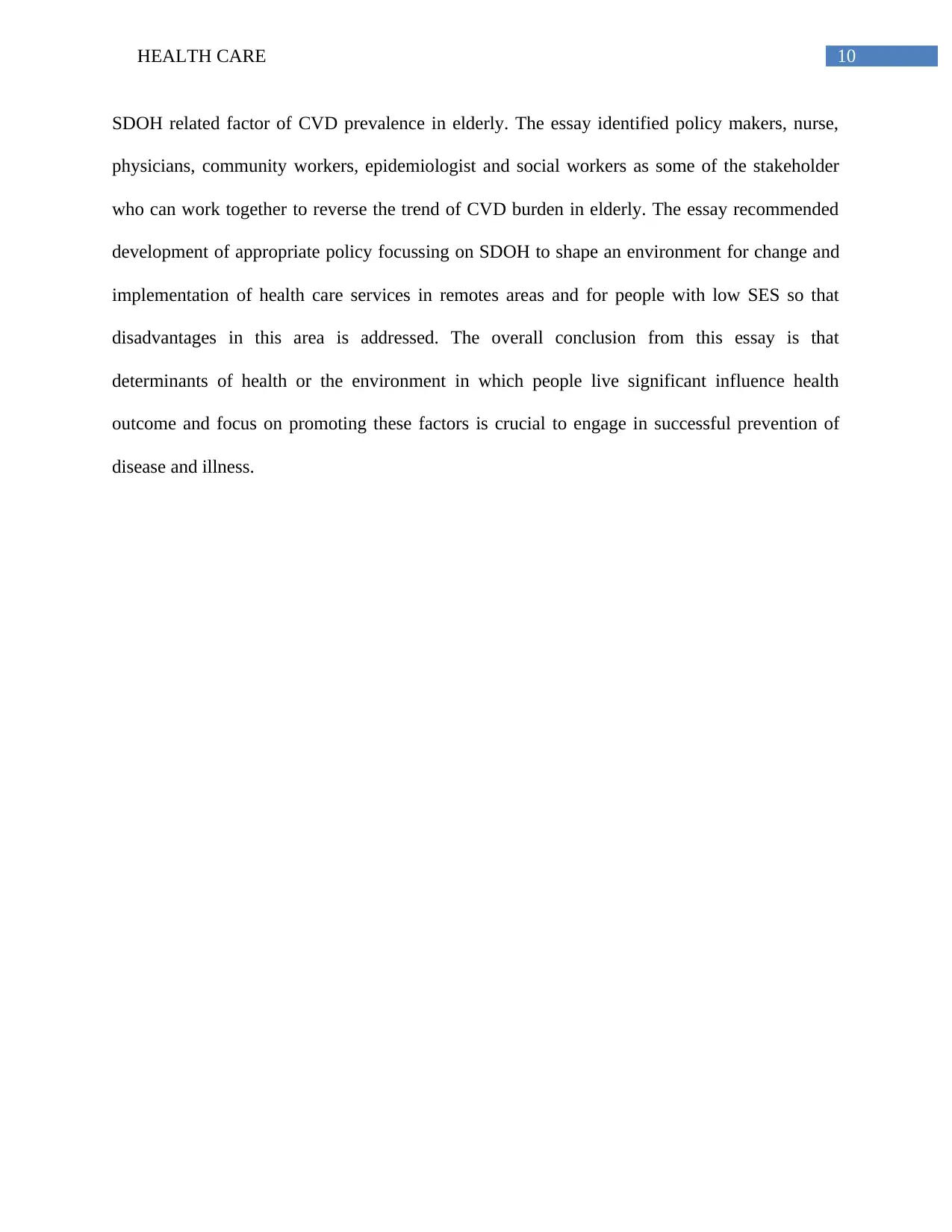
10HEALTH CARE
SDOH related factor of CVD prevalence in elderly. The essay identified policy makers, nurse,
physicians, community workers, epidemiologist and social workers as some of the stakeholder
who can work together to reverse the trend of CVD burden in elderly. The essay recommended
development of appropriate policy focussing on SDOH to shape an environment for change and
implementation of health care services in remotes areas and for people with low SES so that
disadvantages in this area is addressed. The overall conclusion from this essay is that
determinants of health or the environment in which people live significant influence health
outcome and focus on promoting these factors is crucial to engage in successful prevention of
disease and illness.
SDOH related factor of CVD prevalence in elderly. The essay identified policy makers, nurse,
physicians, community workers, epidemiologist and social workers as some of the stakeholder
who can work together to reverse the trend of CVD burden in elderly. The essay recommended
development of appropriate policy focussing on SDOH to shape an environment for change and
implementation of health care services in remotes areas and for people with low SES so that
disadvantages in this area is addressed. The overall conclusion from this essay is that
determinants of health or the environment in which people live significant influence health
outcome and focus on promoting these factors is crucial to engage in successful prevention of
disease and illness.

11HEALTH CARE
References:
Angell, S., Levings, J., Neiman, A., Asma, S., & Merritt, R. (2014). How Policy Makers Can
Advance Cardiovascular Health. Scientific American, 2014(Suppl Spec), 24–29.
Australian Health Policy Collaboration (2017). Heart Health: The first step to Getting
Australia’s Health on Track. Retrieved from:
https://www.vu.edu.au/sites/default/files/ahpc-heart-health-policy-paper.pdf
Australian Institute of Health and Welfare. (2018). Cardiovascular disease snapshot. Retrieved
from: https://www.aihw.gov.au/reports/heart-stroke-vascular-disease/cardiovascular-
health-compendium/contents/how-many-australians-have-cardiovascular-disease
Davy, C., Harfield, S., McArthur, A., Munn, Z., & Brown, A. (2016). Access to primary health
care services for Indigenous peoples: A framework synthesis. International journal for
equity in health, 15(1), 163. doi:10.1186/s12939-016-0450-5
Greco, M., Sood, A., Kwon, S. and Ariza, A.J., 2016. Cardiovascular risk factor screening and
management of obese patients at an outpatient pediatric cardiology
center. SpringerPlus, 5(1), p.1868.
Havranek, E. P., Mujahid, M. S., Barr, D. A., Blair, I. V., Cohen, M. S., Cruz-Flores, S., ... &
Rosal, M. (2015). Social determinants of risk and outcomes for cardiovascular disease: a
scientific statement from the American Heart Association. Circulation, 132(9), 873-898.
Heart Foundation (2017). Heart disease in Australia. Retrieved from:
https://www.heartfoundation.org.au/about-us/what-we-do/heart-disease-in-australia
References:
Angell, S., Levings, J., Neiman, A., Asma, S., & Merritt, R. (2014). How Policy Makers Can
Advance Cardiovascular Health. Scientific American, 2014(Suppl Spec), 24–29.
Australian Health Policy Collaboration (2017). Heart Health: The first step to Getting
Australia’s Health on Track. Retrieved from:
https://www.vu.edu.au/sites/default/files/ahpc-heart-health-policy-paper.pdf
Australian Institute of Health and Welfare. (2018). Cardiovascular disease snapshot. Retrieved
from: https://www.aihw.gov.au/reports/heart-stroke-vascular-disease/cardiovascular-
health-compendium/contents/how-many-australians-have-cardiovascular-disease
Davy, C., Harfield, S., McArthur, A., Munn, Z., & Brown, A. (2016). Access to primary health
care services for Indigenous peoples: A framework synthesis. International journal for
equity in health, 15(1), 163. doi:10.1186/s12939-016-0450-5
Greco, M., Sood, A., Kwon, S. and Ariza, A.J., 2016. Cardiovascular risk factor screening and
management of obese patients at an outpatient pediatric cardiology
center. SpringerPlus, 5(1), p.1868.
Havranek, E. P., Mujahid, M. S., Barr, D. A., Blair, I. V., Cohen, M. S., Cruz-Flores, S., ... &
Rosal, M. (2015). Social determinants of risk and outcomes for cardiovascular disease: a
scientific statement from the American Heart Association. Circulation, 132(9), 873-898.
Heart Foundation (2017). Heart disease in Australia. Retrieved from:
https://www.heartfoundation.org.au/about-us/what-we-do/heart-disease-in-australia
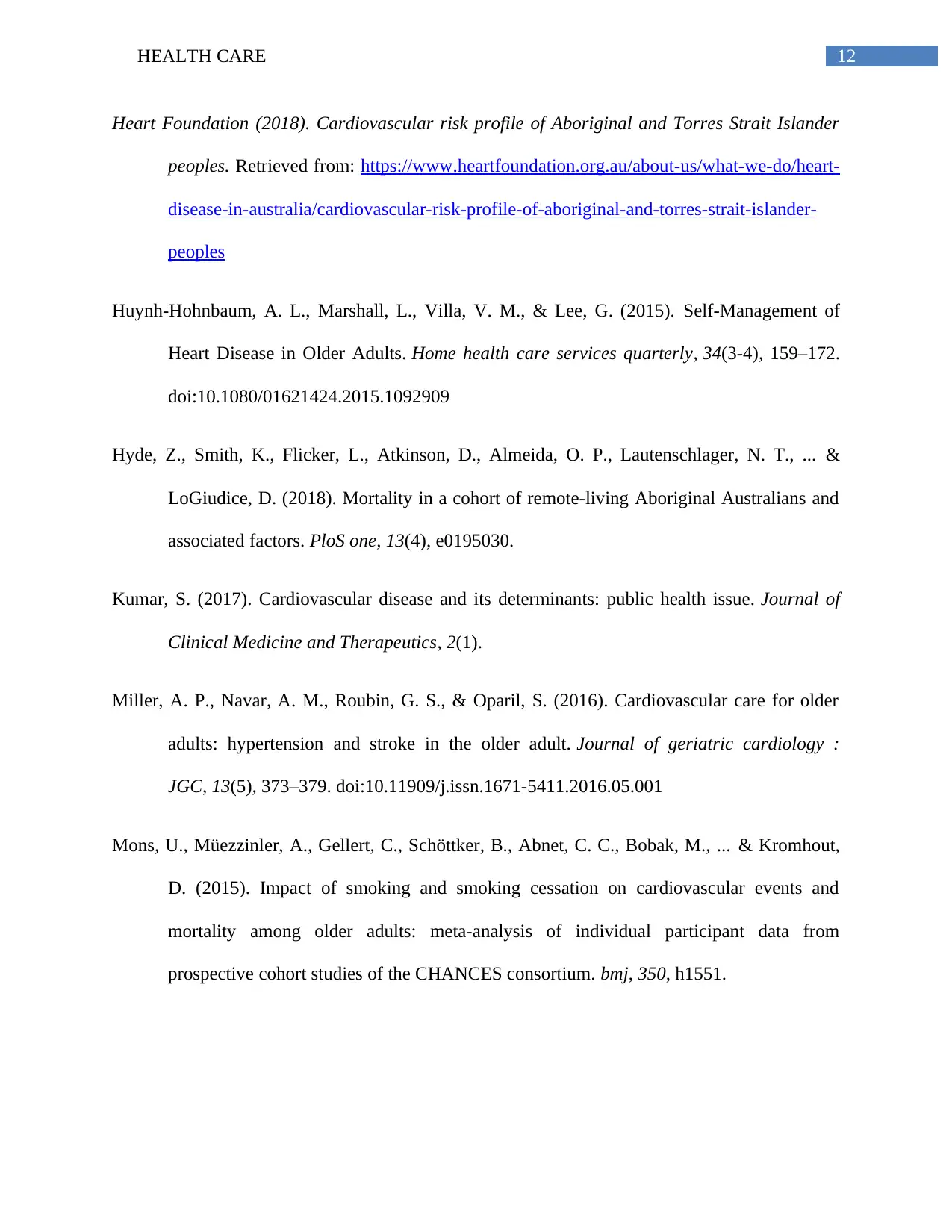
12HEALTH CARE
Heart Foundation (2018). Cardiovascular risk profile of Aboriginal and Torres Strait Islander
peoples. Retrieved from: https://www.heartfoundation.org.au/about-us/what-we-do/heart-
disease-in-australia/cardiovascular-risk-profile-of-aboriginal-and-torres-strait-islander-
peoples
Huynh-Hohnbaum, A. L., Marshall, L., Villa, V. M., & Lee, G. (2015). Self-Management of
Heart Disease in Older Adults. Home health care services quarterly, 34(3-4), 159–172.
doi:10.1080/01621424.2015.1092909
Hyde, Z., Smith, K., Flicker, L., Atkinson, D., Almeida, O. P., Lautenschlager, N. T., ... &
LoGiudice, D. (2018). Mortality in a cohort of remote-living Aboriginal Australians and
associated factors. PloS one, 13(4), e0195030.
Kumar, S. (2017). Cardiovascular disease and its determinants: public health issue. Journal of
Clinical Medicine and Therapeutics, 2(1).
Miller, A. P., Navar, A. M., Roubin, G. S., & Oparil, S. (2016). Cardiovascular care for older
adults: hypertension and stroke in the older adult. Journal of geriatric cardiology :
JGC, 13(5), 373–379. doi:10.11909/j.issn.1671-5411.2016.05.001
Mons, U., Müezzinler, A., Gellert, C., Schöttker, B., Abnet, C. C., Bobak, M., ... & Kromhout,
D. (2015). Impact of smoking and smoking cessation on cardiovascular events and
mortality among older adults: meta-analysis of individual participant data from
prospective cohort studies of the CHANCES consortium. bmj, 350, h1551.
Heart Foundation (2018). Cardiovascular risk profile of Aboriginal and Torres Strait Islander
peoples. Retrieved from: https://www.heartfoundation.org.au/about-us/what-we-do/heart-
disease-in-australia/cardiovascular-risk-profile-of-aboriginal-and-torres-strait-islander-
peoples
Huynh-Hohnbaum, A. L., Marshall, L., Villa, V. M., & Lee, G. (2015). Self-Management of
Heart Disease in Older Adults. Home health care services quarterly, 34(3-4), 159–172.
doi:10.1080/01621424.2015.1092909
Hyde, Z., Smith, K., Flicker, L., Atkinson, D., Almeida, O. P., Lautenschlager, N. T., ... &
LoGiudice, D. (2018). Mortality in a cohort of remote-living Aboriginal Australians and
associated factors. PloS one, 13(4), e0195030.
Kumar, S. (2017). Cardiovascular disease and its determinants: public health issue. Journal of
Clinical Medicine and Therapeutics, 2(1).
Miller, A. P., Navar, A. M., Roubin, G. S., & Oparil, S. (2016). Cardiovascular care for older
adults: hypertension and stroke in the older adult. Journal of geriatric cardiology :
JGC, 13(5), 373–379. doi:10.11909/j.issn.1671-5411.2016.05.001
Mons, U., Müezzinler, A., Gellert, C., Schöttker, B., Abnet, C. C., Bobak, M., ... & Kromhout,
D. (2015). Impact of smoking and smoking cessation on cardiovascular events and
mortality among older adults: meta-analysis of individual participant data from
prospective cohort studies of the CHANCES consortium. bmj, 350, h1551.
Paraphrase This Document
Need a fresh take? Get an instant paraphrase of this document with our AI Paraphraser
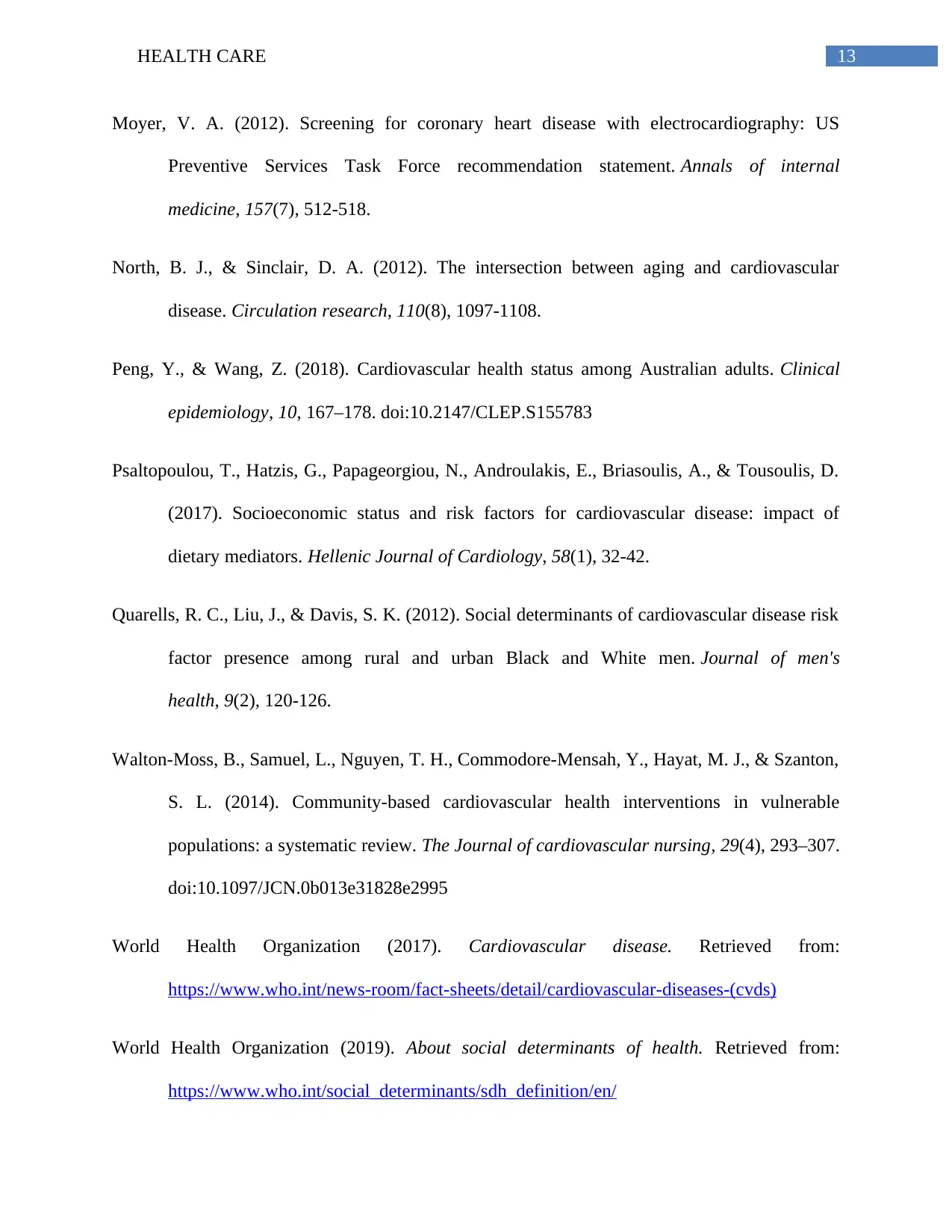
13HEALTH CARE
Moyer, V. A. (2012). Screening for coronary heart disease with electrocardiography: US
Preventive Services Task Force recommendation statement. Annals of internal
medicine, 157(7), 512-518.
North, B. J., & Sinclair, D. A. (2012). The intersection between aging and cardiovascular
disease. Circulation research, 110(8), 1097-1108.
Peng, Y., & Wang, Z. (2018). Cardiovascular health status among Australian adults. Clinical
epidemiology, 10, 167–178. doi:10.2147/CLEP.S155783
Psaltopoulou, T., Hatzis, G., Papageorgiou, N., Androulakis, E., Briasoulis, A., & Tousoulis, D.
(2017). Socioeconomic status and risk factors for cardiovascular disease: impact of
dietary mediators. Hellenic Journal of Cardiology, 58(1), 32-42.
Quarells, R. C., Liu, J., & Davis, S. K. (2012). Social determinants of cardiovascular disease risk
factor presence among rural and urban Black and White men. Journal of men's
health, 9(2), 120-126.
Walton-Moss, B., Samuel, L., Nguyen, T. H., Commodore-Mensah, Y., Hayat, M. J., & Szanton,
S. L. (2014). Community-based cardiovascular health interventions in vulnerable
populations: a systematic review. The Journal of cardiovascular nursing, 29(4), 293–307.
doi:10.1097/JCN.0b013e31828e2995
World Health Organization (2017). Cardiovascular disease. Retrieved from:
https://www.who.int/news-room/fact-sheets/detail/cardiovascular-diseases-(cvds)
World Health Organization (2019). About social determinants of health. Retrieved from:
https://www.who.int/social_determinants/sdh_definition/en/
Moyer, V. A. (2012). Screening for coronary heart disease with electrocardiography: US
Preventive Services Task Force recommendation statement. Annals of internal
medicine, 157(7), 512-518.
North, B. J., & Sinclair, D. A. (2012). The intersection between aging and cardiovascular
disease. Circulation research, 110(8), 1097-1108.
Peng, Y., & Wang, Z. (2018). Cardiovascular health status among Australian adults. Clinical
epidemiology, 10, 167–178. doi:10.2147/CLEP.S155783
Psaltopoulou, T., Hatzis, G., Papageorgiou, N., Androulakis, E., Briasoulis, A., & Tousoulis, D.
(2017). Socioeconomic status and risk factors for cardiovascular disease: impact of
dietary mediators. Hellenic Journal of Cardiology, 58(1), 32-42.
Quarells, R. C., Liu, J., & Davis, S. K. (2012). Social determinants of cardiovascular disease risk
factor presence among rural and urban Black and White men. Journal of men's
health, 9(2), 120-126.
Walton-Moss, B., Samuel, L., Nguyen, T. H., Commodore-Mensah, Y., Hayat, M. J., & Szanton,
S. L. (2014). Community-based cardiovascular health interventions in vulnerable
populations: a systematic review. The Journal of cardiovascular nursing, 29(4), 293–307.
doi:10.1097/JCN.0b013e31828e2995
World Health Organization (2017). Cardiovascular disease. Retrieved from:
https://www.who.int/news-room/fact-sheets/detail/cardiovascular-diseases-(cvds)
World Health Organization (2019). About social determinants of health. Retrieved from:
https://www.who.int/social_determinants/sdh_definition/en/
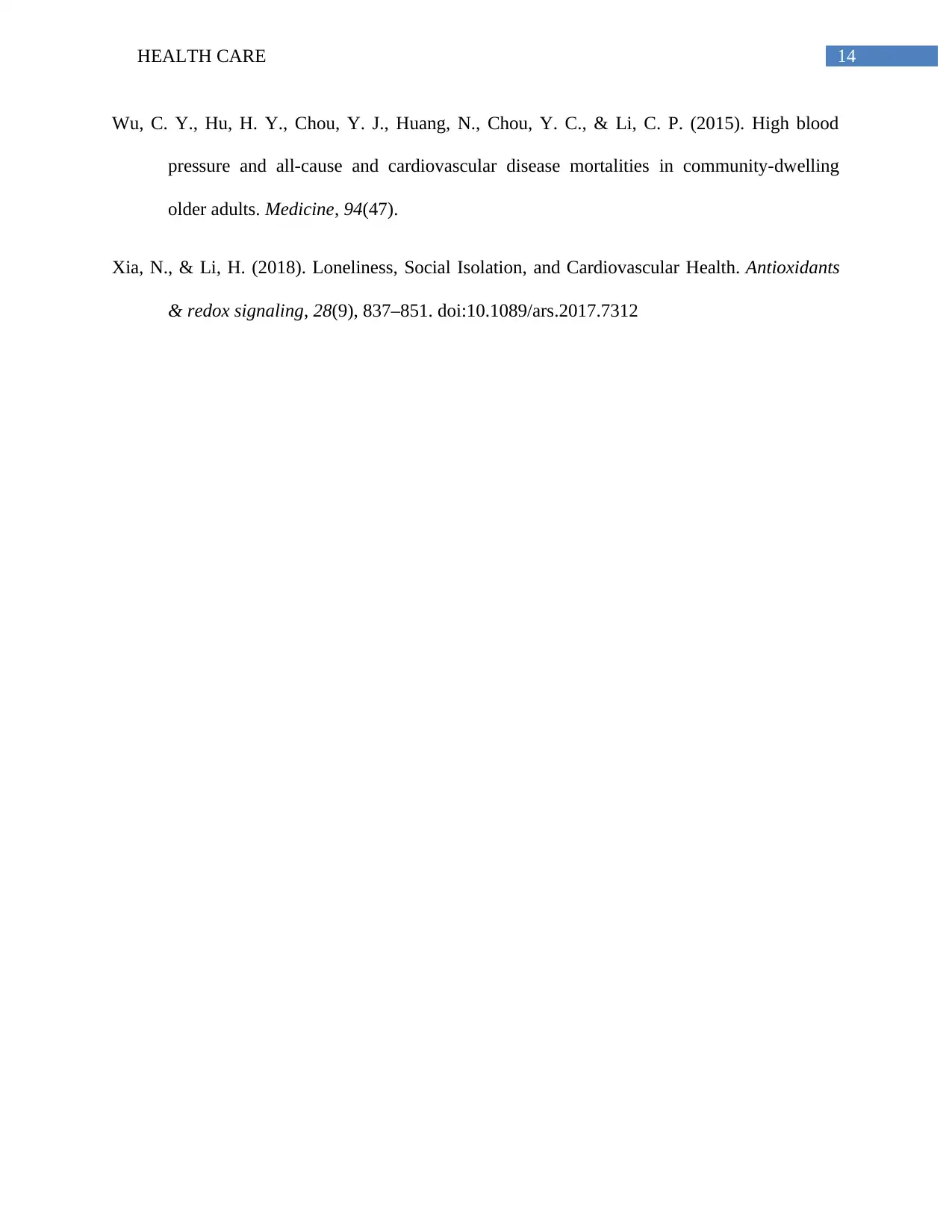
14HEALTH CARE
Wu, C. Y., Hu, H. Y., Chou, Y. J., Huang, N., Chou, Y. C., & Li, C. P. (2015). High blood
pressure and all-cause and cardiovascular disease mortalities in community-dwelling
older adults. Medicine, 94(47).
Xia, N., & Li, H. (2018). Loneliness, Social Isolation, and Cardiovascular Health. Antioxidants
& redox signaling, 28(9), 837–851. doi:10.1089/ars.2017.7312
Wu, C. Y., Hu, H. Y., Chou, Y. J., Huang, N., Chou, Y. C., & Li, C. P. (2015). High blood
pressure and all-cause and cardiovascular disease mortalities in community-dwelling
older adults. Medicine, 94(47).
Xia, N., & Li, H. (2018). Loneliness, Social Isolation, and Cardiovascular Health. Antioxidants
& redox signaling, 28(9), 837–851. doi:10.1089/ars.2017.7312
1 out of 15
Related Documents
Your All-in-One AI-Powered Toolkit for Academic Success.
+13062052269
info@desklib.com
Available 24*7 on WhatsApp / Email
![[object Object]](/_next/static/media/star-bottom.7253800d.svg)
Unlock your academic potential
© 2024 | Zucol Services PVT LTD | All rights reserved.





